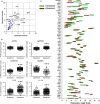Analysis of individual cells identifies cell-to-cell variability following induction of cellular senescence
- PMID: 28699239
- PMCID: PMC5595671
- DOI: 10.1111/acel.12632
Analysis of individual cells identifies cell-to-cell variability following induction of cellular senescence
Abstract
Senescent cells play important roles in both physiological and pathological processes, including cancer and aging. In all cases, however, senescent cells comprise only a small fraction of tissues. Senescent phenotypes have been studied largely in relatively homogeneous populations of cultured cells. In vivo, senescent cells are generally identified by a small number of markers, but whether and how these markers vary among individual cells is unknown. We therefore utilized a combination of single-cell isolation and a nanofluidic PCR platform to determine the contributions of individual cells to the overall gene expression profile of senescent human fibroblast populations. Individual senescent cells were surprisingly heterogeneous in their gene expression signatures. This cell-to-cell variability resulted in a loss of correlation among the expression of several senescence-associated genes. Many genes encoding senescence-associated secretory phenotype (SASP) factors, a major contributor to the effects of senescent cells in vivo, showed marked variability with a subset of highly induced genes accounting for the increases observed at the population level. Inflammatory genes in clustered genomic loci showed a greater correlation with senescence compared to nonclustered loci, suggesting that these genes are coregulated by genomic location. Together, these data offer new insights into how genes are regulated in senescent cells and suggest that single markers are inadequate to identify senescent cells in vivo.
Keywords: aging; cellular senescence; cytokines; single cell; transcriptomics.
© 2017 The Authors. Aging Cell published by the Anatomical Society and John Wiley & Sons Ltd.
Figures




Similar articles
-
Rapamycin inhibits the secretory phenotype of senescent cells by a Nrf2-independent mechanism.Aging Cell. 2017 Jun;16(3):564-574. doi: 10.1111/acel.12587. Epub 2017 Mar 31. Aging Cell. 2017. PMID: 28371119 Free PMC article.
-
Quantitative identification of senescent cells in aging and disease.Aging Cell. 2017 Aug;16(4):661-671. doi: 10.1111/acel.12592. Epub 2017 Apr 28. Aging Cell. 2017. PMID: 28455874 Free PMC article.
-
Targeting genes in insulin-associated signalling pathway, DNA damage, cell proliferation and cell differentiation pathways by tocotrienol-rich fraction in preventing cellular senescence of human diploid fibroblasts.Clin Ter. 2015 Nov-Dec;166(6):e365-73. doi: 10.7417/T.2015.1902. Clin Ter. 2015. PMID: 26794818
-
Targeting metabolism in cellular senescence, a role for intervention.Mol Cell Endocrinol. 2017 Nov 5;455:83-92. doi: 10.1016/j.mce.2016.08.049. Epub 2016 Aug 31. Mol Cell Endocrinol. 2017. PMID: 27591812 Review.
-
Transcriptomic Analysis of Cellular Senescence: One Step Closer to Senescence Atlas.Mol Cells. 2021 Mar 31;44(3):136-145. doi: 10.14348/molcells.2021.2239. Mol Cells. 2021. PMID: 33795532 Free PMC article. Review.
Cited by
-
The biological mechanism and emerging therapeutic interventions of liver aging.Int J Biol Sci. 2024 Jan 1;20(1):280-295. doi: 10.7150/ijbs.87679. eCollection 2024. Int J Biol Sci. 2024. PMID: 38164175 Free PMC article. Review.
-
Role of Senescent Cells in Cutaneous Wound Healing.Biology (Basel). 2022 Nov 29;11(12):1731. doi: 10.3390/biology11121731. Biology (Basel). 2022. PMID: 36552241 Free PMC article. Review.
-
WNT/beta-catenin signalling interrupts a senescence-induction cascade in human mesenchymal stem cells that restricts their expansion.Cell Mol Life Sci. 2022 Jan 20;79(2):82. doi: 10.1007/s00018-021-04035-x. Cell Mol Life Sci. 2022. PMID: 35048158 Free PMC article.
-
Cellular senescence and neurodegeneration.Hum Genet. 2023 Aug;142(8):1247-1262. doi: 10.1007/s00439-023-02565-x. Epub 2023 Apr 28. Hum Genet. 2023. PMID: 37115318 Review.
-
Short-term gain, long-term pain: the senescence life cycle and cancer.Genes Dev. 2019 Feb 1;33(3-4):127-143. doi: 10.1101/gad.320937.118. Genes Dev. 2019. PMID: 30709901 Free PMC article. Review.
References
-
- Bahar R, Hartmann CH, Rodriguez KA, Denny AD, Busuttil RA, Dolle ME, Calder RB, Chisholm GB, Pollock BH, Klein CA, Vijg J (2006) Increased cell‐to‐cell variation in gene expression in ageing mouse heart. Nature 441, 1011–1014. - PubMed
Publication types
MeSH terms
Substances
Grants and funding
LinkOut - more resources
Full Text Sources
Other Literature Sources

